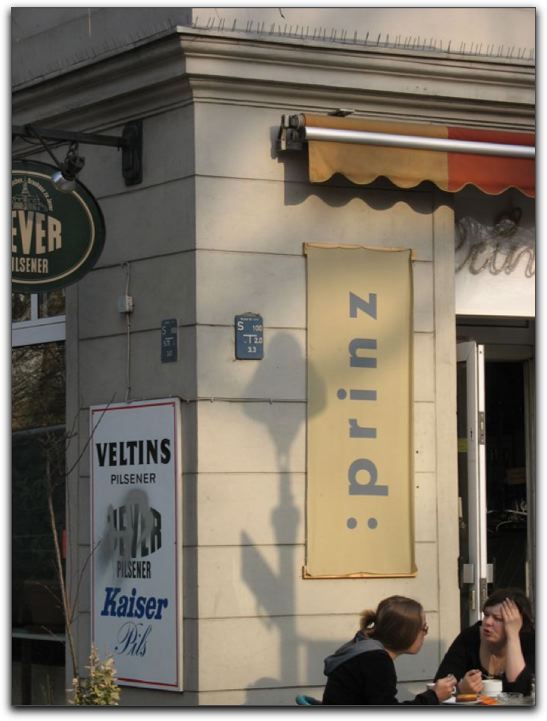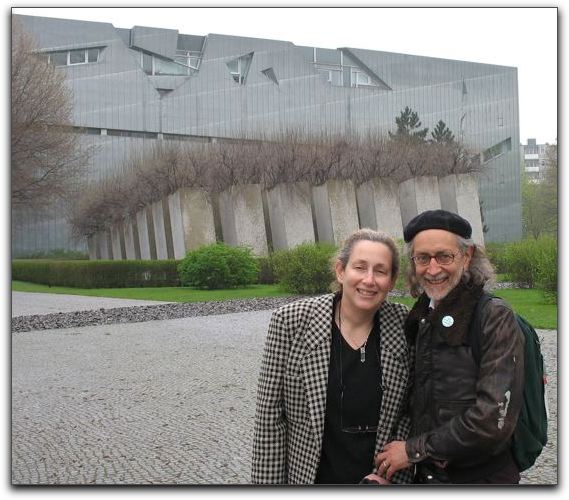
Into Germany: At the border between Poland and Germany passports were checked where we had to show the police report instead of the documentation for the car.
We were a bit surprised to feel relieved to be in Germany, with a language and life style that was more familiar. We even found Trader Joe's California Plums (canned, of course) in the tiny market in Joachimstadt!
 After the usual search for the campsite--Gerdy directed us first to a non existent camp site (across the street from a "Prinz" cafe) Just to the right of the two women in the photo was a couple sitting at another table. The man at the table watched me [Mark] take the photo... as though I was some kind of undercover agent,
After the usual search for the campsite--Gerdy directed us first to a non existent camp site (across the street from a "Prinz" cafe) Just to the right of the two women in the photo was a couple sitting at another table. The man at the table watched me [Mark] take the photo... as though I was some kind of undercover agent,

Mark checked the internet at a cybercafe/bicycle tour/rental shop at the base of the Alexanderplatz needle and found two addresses. We ended up at the closest, what turned out to be a camping club where folks pretty much leave their campers and use them during the summer and weekends. The manager woman was not so friendly or helpful, but we settled in comfortably. The next morning we enjoyed spring in the very pretty Tiergarten, found the "Stelenfeld" Holocaust memorial with its very peculiar plaque.

Hardly a mention about the memorial on the plaque but lots of prohibitions about behavior there. We only later learned that we had missed the accompanying museum, but how were we to know, there were no signs.
The memorial is huge, taking up an entire city block in downtown Berlin... a block away from the Brandenberg Gate. It is rather stark and imposing. I [Mark] don't know how much "explanation" is needed other than to know that it is for the murdered Jews of Europe. While each of the steles is strictly rectilinear, the irregularity of their height and the "floor" causes an individuality and disorientation that I found moving. It was easy to lose your balance and your partner inside.


More walking to a German version of Starbucks called Meyerbeer (yes, named after Giacomo). A plaque on the wall explains who Meyerbeer was, but they had no information in English and I could not figure out Why is this coffee shop named after a German Jewish composer?

Continuing on our way to the Neue Synagoge aka Orianenberger Strasse Synagoge, once again a synagogue now mostly a museum. The exhibit describes the reconstruction of the impressive dome, mentions Joachim Prinz (minimal) and Regina Jonas (some), the first woman ordained rabbi and sadly killed at Auschwitz, whose duties at the synagogue and in the community never included preaching or conducting the service.
After finding internet and some groceries we returned to the Neue Synagoge for services,with a liberal group that meets in a very simple chapel on the third floor. The shlichat tzibbur had a lovely voice though sang a lot in the same manner. As we had seen in Vienna, the rabbi or leader blessed the children under a Tallit. In Berlin, each of the children received one of those Kinder eggs with toys inside. At the end of the service a man came up to us and said we looked familiar. We had been glancing at him as well. Rabbi Dan Bridge, a Reform colleague from Hillel at University of Washington in Seattle, who is also the second cousin (?) of one of Avigail's classmates from Reed, kindly invited us to join him for Shabbat dinner. Indeed, Av had visited Yael's family in Seattle in their first year. Dan was close with Marianne Gevirtz as well. He's in Berlin for a month, renting a flat, part of his nine month Sabbatical. We had a great time hearing about his travels, his retirement plans, his kids, and then went off together on an adventure to the Kit Kat Club. This is definitely not the Kit Kat Club of "Cabaret". If you're curious, you can ask me and I'll share a bit more info... or, if you're resourceful, you can probably find out for yourself. We had a great time and owe him a Shabbat dinner. As it turned out to be a late night and we wanted to get to services in the morning, we slept on his couch.
Services in the morning were at The Pestalozzistrasse Synagogue, which we especially wanted to attend when we heard that the mixed choir of non Jews and the Cantor from Israel sing only the music of Louis Lewandowski. The older rabbi seemed sweet, welcomed guests from San Diego (us), and spoke about holiness, railing against the "shmutz" out there. The sit down Kiddush honored an 80th birthday. We happened to sit with a couple of young men who spoke reasonably good English. Between solo performances which seemed like birthday "offerings" of the choir members, Cantor and presentations on occasion of several birthdays, we learned that they (these two young men) feel anti-Semitism, that they chose this synagogue because one of them likes the rabbi, and the other guy because it's close. They come every week. Since journalist/Phd candidate Frank was going in the direction of the Jewish Museum, he escorted us there and stayed with us. He took the portrait photo that day.
Re: The Berlin Jewish Museum --from an educational point of view, cleverly presented in parts: the Moses Mendelsohn coin (pressing a .05 Euro coin; Mark got one... photo coming), the birthday wish list of a German Jewish child, the what would you pack if you had to leave your home, and other interesting opportunities for children. Mark was pleased to find more graphics by Jakob Steinhardt, E. M. Lillien, Budko (et. al. including the work of a woman whose name I was not familiar with); on the other hand, he was surprised that Kurt Weill was not mentioned.
As we wrote to Noam when he asked us about the Berlin Jewish Museum: the pieces falling out of the walls onto the ground, suggest the literal destruction as well as things out of control. The bottom floor of exile with all of its very personal stories, suggesting the many other stories, the disorientation of the dislocations and deportations, the uneven floors and the uncertainty about which way to turn--I [Debbie] liked all of that. The rest of the exhibit, while interesting--especially the Christmas/Chanukah Weihnukkah info, the area about Regina Jonas the first woman rabbi and the birthday wish list for kids--seemed confusing regarding the sequence with Holocaust on first floor and then again at the end.
I [Mark] found it unnecessarily complex. So complex that the items you looked at such as constructions by Libeskind, had explanations by him, explaining what we were to see/experience. Bad form. The passage that leads to the "tower of void" needs a double door so that people going in and out do not add light to the room that should receive light only from the tiny opening at the top. The 48 columns with "olive willows" (whatever those are) do not make any sense. What is the number 48? Liebeskind says it's for 1948, but that's not a "Jewish" number. Maybe 49 he could use? And maybe we are confused... unless one column (tree) is missing, the photo indicates 7x7 (or 49)!

The museum portion itself had some interesting material, but I found nothing (when it came to the pre-Shoa period) mentioning Joachim Prinz, nor Kurt Weill. I'm not being self-centered here, but I think those are serious omissions. Even aside from that, the pathways in the museum portion of the museum crossed over each other and so, there are (added later?) spots with arrows showing where you are to walk. And, even these cross each other. I did not find it a good experience as a museum, nor as a Shoa memorial. I'm working on a new section of the Web site that reviews those memorials we've found.
Later that day Mark found another manifestation of Prinz in Berlin:
Berlin.a.jpg)
On Sunday morning April 23, we planned to spend the day around the campsite by the river and forest and then go back into Berlin to visit some more sites on our way out of town the next day. However, as we were leaving, Mark locked the keys in the van. Fortunately the campsite's reception people (daughter in law and son, mostly) spoke a bit of English and were willing to call the German version of AAA, the ADAC, which has some reciprocal relationship. They came in an hour and after trying driver's side opened the passenger side. Another adventure. Then we set off for a nice long walk (4 miles?) in the area, in the forest and the Hevel river in the suburb of Gatow, across from the from Grunewald Forest, just north of Wannsee (see portrait of that day). On our walk we came upon the aptly named "Wasted Effort Casino" (cf. Kohelet 1:2 [Ecclesiastes in Hebrew]).

We had driven through the Charlottenburg area of Berlin a few times, but, we were not able to find my [Debbie's] Mom's addresses in Berlin. At the same time, though, I [Debbie] have to say that we did not try very hard either. We probably needed to check at the Museum or the Leo Baeck Institute but maybe we can do that on line. While in Charlottenburg we did get a decent look at the 1936 Olympic stadium.
Monday, our last day in Berlin we tried to make the 10:00 AM free walking tour but ran about an hour late, even though we were earlier than usual. We decided we could do it all ourselves though the tour would have given us much more info. We waited the 1 1/2 hours to get into the Reichstag, where we enjoyed the view and the design of the dome. We visited the Gehry designed DG Bank building with a Gehry sculpture conference room inside.
We continued on to the Bebelplatz. We saw a couple of instances where Germany is doing what it can to "reinvent" itself as "The Land of Ideas". Near the Brandenberg Gate there was a huge sculpture of a car that looked like an old Claes Oldenburg with a sign beside it with the above-quoted title. Another was here at the Bebelplatz (the nerve!).

I (m) had not read the sign at the Brandenberg Gate. Here, while behind me is a pile of books of (as Brecht once wrote) "the banned poets" (in another faux-Oldenberg, with Brecht himself in the pile) you can faintly see that Germany is now proudly the land of modern book printing.
This spot commemorates the Nazi book burning in 1933. The sculpture there "Bibliothek" ("Library") by Micha Ulman (a subterranean library with empty shelves... enough for the number of books that were burned)

remind visitors that Heinrich Heine, already 100 years earlier, had warned that those who burn books will one day burn people.

It is reassuring to see that there are now book sellers on the street right there

(and a short story written about the Bebelplatz on the Web).
Overall, while there is much to see and do in Berlin, I [Debbie] found it hard to be there--not just the dreary weather for several days but the overwhelming number of complex historical realities. I'm not sure that I would go back... well, yes, for a free trip (...for the children of Jews born in Berlin, perhaps).